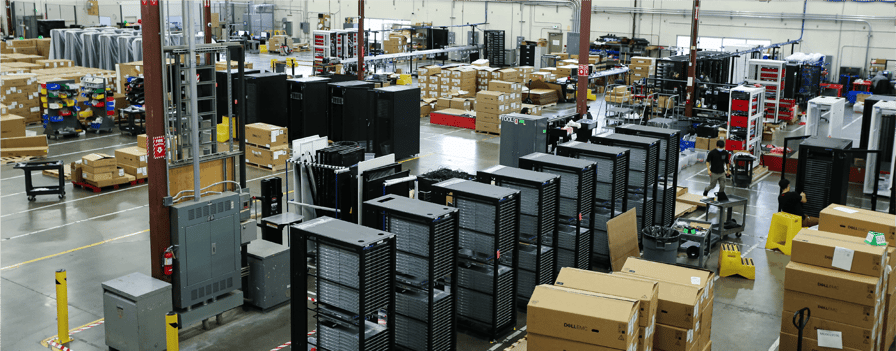Under normal conditions, deploying new datacenter infrastructure is complicated. Supply chain management, scheduling, travel, installation—each of these steps to get new hardware up and running presents its own set of challenges.
Add a global pandemic, shutdowns, and major impediments to critical components to the mix and every potential hiccup is amplified.
While equipment and component procurement, which leans heavily upon production in Asia, has started to recover from COVID-19, shipping and transportation plans still routinely hit delays. At the same time, most datacenters are still operating under restrictions, and the travel often involved in deploying new infrastructure remains unappealing to most enterprises.
In order to navigate this tangled knot of denials and delays, many companies that need to deploy the new racks and hardware critical to their function have been left scrambling.
The rack integration remedy
At a high level, getting new infrastructure up and running is a five-step process: design, procurement, build, shipping, and deployment.
Within each of these steps are potential pain points for enterprises, including delays, hardware faults, and shipping coordination.

Since each of these potential pain points comes with a price tag, it isn’t uncommon for those taking a DIY approach in deploying new infrastructure to experience sticker shock once all the new hardware is up and running.
Rack integration services exist to alleviate all the above issues. For mid-sized and rapidly growing enterprises in particular, the services provide an easy and cost-effective way to deploy datacenter hardware at scale without the need to invest in dedicated in-house teams, integration facilities, and rigorous quality control processes.
While the services themselves may vary depending on the provider, at a base level, they should all:
Design a server and rack architecture that meets the enterprise’s unique needs
Locate, procure, and handle the logistics of all hardware and ancillary equipment based on that design
Ensure all equipment is properly tested and software integrated
Deploy and oversee installation of the new hardware at the enterprise’s datacenters
Outsourcing this process doesn’t just save you time and resources. By partnering with an integration provider to oversee the entire deployment process, you can focus on your core business rather than your infrastructure—which, in the end, is exactly where your focus should be.
Current events and the value of the first article
COVID-19 restrictions have also cast a renewed light on the critical importance of the first article process.
While this process can take on different definitions depending on the rack integration services provider, here at Redapt the goal of our first article process is to greatly streamline the infrastructure deployment process.

This means that, along with the rack integration steps listed above, our focus is on delivering racks that are turnkey and consistently of high quality. To do this, we work in collaboration with each customer to:
- Construct a detailed engineering document based on the architecture design of the new racks
- Have every piece of equipment shipped to our facilities for unboxing, assembly, and testing
- Fully implement the build, including configuring firmware, bios to customer specification with automation, bend radiuses of cables, choice of cable coloring and label fonts, and software integration
- Coordinate all logistics and handle all aspects of the arrival and unpacking of the equipment at the datacenter, including the removal of all packaging and recyclable materials
- Oversee the deployment of new racks that have already been assembled, cabled, and optimized in order to increase efficiency and ROI
Once a first article is delivered and accepted by the client, they can take a less involved approach in all future rack deployments.
Speed without sacrificing quality
In today’s business, being able to scale efficiently is a cornerstone of remaining competitive.
By avoiding delays in the deployment of new infrastructure, enterprises are better able to meet the increasing demands of customers without incurring substantial costs. At the same time, speed should never mean forgoing quality, especially for critically important infrastructure like server racks.
Now more than ever, enterprises that aren’t deploying at a scale that requires dedicated rack integration teams should leverage the expertise of rack integration providers. That way, they can place themselves in the best position to deploy high-quality, fully tested hardware without overspending on time and resources.
Learn more about why Redapt is a leader in rack integration services.
Focus your time and resources on creating better products and services for your customers
Let Redapt manage the design, build, and deployment of the datacenter infrastructure you need—when and where you need it.
















